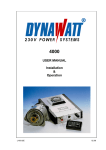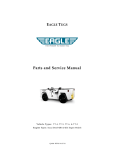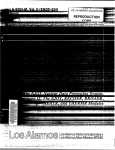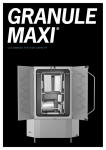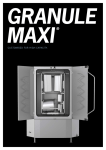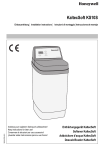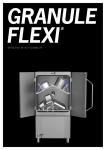Download USER MANUAL Installation & Operation
Transcript
5000 USER MANUAL Installation & Operation 02.08 1 Congratulations on your purchase of a DYNAWATT 230V POWER SYSTEM 5000. You have now acquired a high quality, precision-manufactured power supply system for mobile use. Please read these Operating Instructions through carefully before using the system for the first time. In any event, installation should only be carried out by a qualified technical workshop. Manufacturer: DYNAWATT AG Zinkereistrasse 35 8633 Wolfhausen Switzerland Tel: +41-55-253 26 00 Fax: +41-55-253 26 09 www.dynawatt .ch 2 SYSTEM DATA The DYNAWATT 230V Power System consists of three parts. They are: 1. Generator 2. Control unit 3. Remote control Figure 1 Figure 2 Figure 3 Page: 19 Page: 20 Page: 21 (option) The basic system also comes with 2x installation brackets, 6m of generator cable. Please note the following information on your system. Generator: Series No. ........................ Control unit: Series No. ........................ SAFETY PRECAUTIONS • The DYNAWATT Power System 5000 generates an output voltage of 230V AC. When operating the system please therefore observe the general safety regulations for using electrical equipment. In other words e.g. do not allow any liquids to get into the housing, do not use any sharp instruments, in particular do not insert any metallic objects into the ventilation slot! • The system is electrically insulated (galvanic separation between electronics and housing) and is not earthed to the chassis. (IT mains installation with potential compensation) • When the engine is running the circuits are live. In order to ensure optimum cooling the unit must be installed vertically and the ventilation slots kept clear. • All installation screws (installation kit) must be secured to prevent accidental loosening by using Loctite. IMPORTANT Installation and maintenance of the system should only be carried out by trained personnel. Any faults which are attributable to the use of components other than the components supplied by DYNAWATT AG, or the failure to observe the safety instructions as specified above, are not covered by the warranty. A Power Transfer Switch must be installed if the vehicle (boat etc.) can also be connected to other power sources e.g. 230V external power (shore power), generator, inverter etc. Failure to comply with this instruction will cause damage to the control unit, this damage is not covered by the guarantee. Power Transfer Switches are available from DYNAWATT as an option. 3 INDEX OF CONTENTS SAEFTY PRECAUTIONS 3 INDEX OF CONTENTS 2 TECHNICAL SPECIFICATION 7 CONTROL UNIT GENERATOR 7 7 ADDITIONAL COMPONENTS 8 REMOTE CONTROL POWER TRANFER SWITCH 8 8 LIST OF PARTS SUPPLIED 8 PARTS REQUIRED, NOT SUPPLIED 8 GENERATOR SPEED AND AVAILABLE POWER 9 GENERATOR SPEED AVAILABLE OUTPUT IN WATTS 9 9 INTRODUCTION 10 MANUAL CONTENT 10 SYSTEM DESCRIPTION 10 GENERATOR AND CONTROL UNIT REMOTE CONTROL POWER TRANSFER SWITCH 10 10 10 OPERATION 11 ENGINE SPEED OVERLOAD START PHASE REMOTE CONTROL (OPTION) OFF ON INCREASE SPEED OVERLOAD UNDERVOLTAGE SHORT CIRCUIT SYSTEM ON AND OFF 11 11 11 12 12 12 12 12 12 13 13 PERIODIC MAINTENANCE 13 GENERATOR DRIVE BELT GENERATOR BEARINGS AND BRUSHES 13 13 4 Installation Guidelines and Safety Precautions 14 GENERATOR 14 INSTALLATIONS SITE CHOICE OF BELT PULLEY CHOICE OF BELT BELT PULLEY ALIGNMENT 14 14 15 15 INSTALLATION 16 GENERATOR INSTALLATION FITTING THE GENERATOR COVER GENERATOR MAGNETIZATION CONTROLLING RPM OF VEHICLES ENGINES CONTROL UNIT MOUNTING CONNECTION THE GENERATOR CABLE 230 V CONNECTION 16 16 16 16 17 17 17 STARTING THE SYSTEM 18 TROUBLESHOOTING 18 TESTING THE GENERATOR 18 WARRANTY TERMS 19 LIST OF FIGURES 20 - 29 5 List of Figures All figures can be found at the back of the manual, listed in the order of the figure numbers. Figure Page Description 1 17 Generator 2 18 Control Unit 3 19 Remote Control 4 20 Generator Performance Curve 5 21 Preparing the Connection Cable 6 22 Generator and 230V Connection Terminals 7 23 Power Transfer Switch 8 24 Control Unit Installation 9 25 Generator Installation 10 26 System Block Diagramm 6 Technical Specification CONTROL UNIT Output voltage: Phases: Transformation: Frequency: Output wave: Output power: Start-up current: Efficiency: Weight: Protection category: System Protection: Dimensions: No Load: 230 - 232 V AC Load: 235 - 237 V AC 1 phase 250V by the generator to 230V 50 Hz ± 0.5% sine wave 5000 VA intermittent @ 6000rpm generator 4800 VA continuous (25° C temp.) 70 Amp (5ms) 96% 9 kg IP 21 System automatically shuts of by: overheating or short circuit (double fault) See Figure 1 GENERATOR Power output: Output voltage: Output frequency: Generator speed: Weight: Belt pulley: Efficiency: Insulation category: Phase resistance: Resistance rotor: Dimensions: Cable: max. 5300 Watt (25° C temp.) 3 x 250V AC variable, between 300 and 1500 Hz 15,000 rpm intermittent 13,000 rpm continuous 7.5 kg DIA 60mm, 2 x 9,5mm belt 60% H (170°) 2.8 Ohm ± 0.3 (from phase to phase) 2.5 to 3.5 Ohm See Figure 2 5 X 2.5mm2, 10m (max. 20m on request) REMOTE CONTROL Switch: Indicators Connection cable length: Dimensions: STANDBY / ON add rpm, overload, overheating, short circuit 7.5m available, (max. 20m on request. See Figure 3 7 Additional components Power Transfer Switch A Power Transfer Switch must be installed for switching over from an external power source (e.g. shore power 230V) to on board power source, DYNAWATT. Fig. 7. List of Parts Supplied 1. Generator is supplied with 10m, 5 x 2.5mm2 cable 2. Control unit a. 2 pc. attachment brackets (loose) b. 4 pc. M6 x 10mm attachment screws for brackets (on the back of Control Unit) c. EMI fitting for the generator cable (on the front side of CU) d. Fitting for the 230V cable (on the front side of CU) 3. Remote control with 7.5m cable (available as an option) 4. User manual Parts Required, Not Supplied 1. 2. 3. Three-conductor Output power cable, min. 3x2.5mm2 Vehicle-specific installation sets available on request. 4 pc. attachment screws for the Control Unit Generator Speed and Available Power Calculation Sheet (Note: Measure the belt pulley external diameter) Generator speed Belt pulley dia. generator side: Belt pulley dia. motor side: Motor speed idling: Motor speed max.: Belt pulley transmission: Generator idling rpm: Generator max. rpm: Ra = .......... mm Rm = ......... mm nL = ........... rpm nM = .......... rpm iR = Rm : Ra= ............. NAIdling = (iR) x (nL) = ........ rpm Namax = (iR) x (nM) = ........ rpm Available output in watts Read from the Curve of Figure 21 Power at engine idle speed (NAIdling) Minimum speed for full load .................. Watt .................. rpm 8 Introduction MANUAL CONTENT This manual covers: Operating Instructions, Installation Guidelines and Installation Instructions. SYSTEM DESCRIPTION Generator and Control Unit The system consists of a high performance generator which is belt-driven by the main engine and controlled by the control unit. Whenever the engine is running, a precisely controlled 230V power source with 50 Hz sine wave AC is available, just turn the ON/OFF switch to ON. Remote Control The remote control provides a POWER ON and STANDBY OFF switch and has 4 LED status and fault indicators. Power Transfer Switch A Power Transfer Switch is required for switching between an external power source (230V mains) and the DYNAWATT Power System. WARNING Voltage must never be connected to the control unit! Return voltage will immediately result in the control unit being damaged!! NO WARRANTY 9 OPERATION Figure 4. At full power the system delivers 5000 Watts AC and can deliver higher peak out put on a temporary basis. However, the system automatically limits the output power in case of overload. Overload causes the output voltage to drop, this can have a negative affect on the applied loads. This chapter explains how the user can avoid this situation arising. It deals with four areas. 1. Motor speed 2. Overload 3. Start phase 4. Remote control Engine speed At idling speed the generator delivers a percentage of its potential output. Generation of the maximum output requires a higher engine speed. Figure 4 shows a performance curve for calculating the drive ratio, the output available from the system on idling speed and the minimum engine speed required in order to achieve the system’s maximum output. Overload With most overload situations there are three adjustment options. 1. Reduce the electrical load 2. Increase the motor speed slightly 3. Shut off the entire power consumption temporarily by switching off the control unit or switching to STANDBY on the remote control. The load must then be reduced or the motor speed first increased. Start phase Electrical consumers (in particular electric motors) take up far more current when they are switched on than when in operation. Electric motors are amongst the biggest ‘consumers of electricity, e.g. an air conditioning system which requires 6 - 7 amps when running can require a starting current of up to 50 amps. The DYNAWATT 5000 delivers up to 70 amps starting current. In some situations the user will have to follow the start-up procedure as explaned below: 1. 2. 3. Switch off all loads Switch on the largest load first Switch on the remaining small loads. If the starting current for a load is too high then a soft start can be connected between the DYNAWATT and the user. The soft start reduces the starting current by up to 70% by electronically slowing down the start-up speed of the load. This enables motors with considerably higher starting currents to be operated. Remote control (option) 10 STANDBY The system is switched to ‘STANDBY’ by pressing the toggle switch. In this state there is no voltage on the Output and the ‘STANDBY’ LED light comes on. POWER ON Pressing the toggle switch to ‘POWER ON’ activates the system. The ‘ON’ LED light comes on if the system is switched on. NOTE The control unit mains switch must be set to ON if the remote control is used. Otherwise it will not function. INCREASE SPEED The control unit continuously measures the power output. If the voltage falls by more than 5% under load or because the generator speed is too slow, with the result that the power output is no longer sufficient for the current level of consumption, then the control unit increases the magnetising voltage. Once this reaches the maximum of 14V and the voltage generated is still below 220V then the ‘ADD RPM’ LED light comes on. Remedy: - Increase engine speed - Check belt tension for slippage, tighten or replace belt OVERLOAD Under a overload the current limiter limits the output current to 22.5 amps, the ‘OVERLOAD’ LED will come on, Output Voltage will drop depending on the overload. The system can however still be operated without any problem. CAUSON have to be taken in order not to affect loads applied. Some appliances may be damaged by undervoltage! If there is a sudden heavy load increase the system automatically shuts off and the ‘SHORT CIRCUIT’ LED light comes on. Remedy: Reduce the load, switch the system ON. HIGH TEMPERATURE Overheating A continuously high load or an overload can cause the system to overheat. If the system reaches a temperature of 65°C the ‘HIGH TEMPERATURE’ LED light starts to flash. At 68°C the system automatically shuts off. The system only switches back on automatically once it has cooled down to 52°C. The cause of the overheating can be either incorrect installation, inadequate cooling or a defective fan. Remedy: Check that the Control unit is well ventilated. Test the fan operation, if a suction filter is used the filter may need to be cleaned. 11 SHORT CIRCUIT In the event of a short circuit or a very high load (>70 amps) the control unit automatically switches off and the ‘SHORT CIRCUIT’ LED light comes on. Remedy: Switch off the unit, reduce load or correct the fault. Then switch the unit back ON again. The system does not switch back on automatically after a short circuit. System ON and OFF If the system has been turned off by engine shut down the ON / OFF switch must be rest to off and on again, otherwise the system will not start. Periodic Maintenance Generator Drive Belt The system does not need any periodic maintenance with the exception of checking the belts which are used to drive the generator. We strongly recommend purchasing replacement belts. Where a twin belt system is used both belts must be replaced simultaneously. Only high performance belts should be used, such as e.g. GATES Type ESC or CONTI Industry. NOTE A new V-belt will expand during the first hours of operation and the tension must therefore be subsequently adjusted after the first 10 hours. Generator Bearings and Brushes Depending upon the load and the extent to which the system is used the brushes and bearings should be replaced after approx. 1000 hrs or 80,000 km. Please contact your nearest DYNAWATT dealer for replacements. 12 Installation Guidelines and Safety Precautions IMPORTANT It is essential for the system to be installed professionally to ensure reliable operation over a long period of time. The mechanical installation of the generator is of particular importance. In the event of any problems occurring please contact your DYNAWATT dealer. GENERATOR A number of factors must be taken into account to ensure the generator is correctly installed. Particular attention must be paid to the correct selection criteria. 1. Installation site and stability 2. Choice of belt pulley for the right speed range 3. Choice of belt for minimum system maintenance 4. Belt positioning, alignment and tension. Installation Site The generator can: 1. 2. 3. be fitted to the engine block as an addition to the existing alternator be fitted next to the engine. This requires a special, automatic belt tensioner which is available as an accessory. Whichever choice you make it is essential for the generator to be installed securely. INFORMATION The generator cable should be laid in a separate protective conduit to safeguard it from mechanical effects. Choice of Belt Pulley See Figure 4; System Performance curve. The curve shows that no output is delivered by the system until the generator speed reaches approx. 2900 rpm. and the system generates a 50% output at a generator speed of approx. 3700 rpm. To achieve the best results the system should reach a minimum generator speed of 3500 rpm at engine idle Generator maximum speed: 13,000 rpm continuous 15,000 rpm maximum 13 Choice of Belt The power which is transferred via the belts depends upon the belt width, wrap-around angle, the number of belts and the belt tension. The service life of a single belt system is considerably less than that of a twin belt system. DIA pulley Belt size Type Qty 65 mm 60 mm 65 mm 50 mm 12.5mm 9.5mm 12.5 Micro-V 12.5 ESC toothed 9.5 ESC toothed 12.5 ESC toothed Micro-V 6 grooved 1 2 2 1 Max. output 5000 Watt 5000 Watt STANDARD >5000 Watt 5000 Watt Belt Pulley Alignment Nothing is more important for the service life of a belt than the alignment of the generator pulley and engine pulley. Both pulleys must be absolutely parallel and flush aligned. If a pulley is positioned at an angle to or slightly behind the other this can lead at least to a material related reduction in the useful life of the belt. In addition the belt may slip out of the grooves. INSTALLATION Generator Installation Figure 9. The generator is fitted as an additional alternator. It must be securely and permanently installed since the drive takes two to three times more power than factoryfitted standard alternator. The ratio to be taken into account during installation is dependent upon the engine idling speed and the maximum speed. NOTE All installation screws must therefore be secured using Loctite to prevent accidentally working loose. Fitting the generator cover The generator cover must be positioned in such a way that the generator is able to take in dry, cool air via the intake opening (DIA. 55 mm). If this is not possible then a suction hose must be connected to the opening to provide dry, cool air and must be fitted in an appropriate position in the vehicle. The higher the air intake temperature the greater the heat related loss of generator performance. See Figure 9. 14 Generator Magnetization The generator must be magnetized before installing it otherwise the system may not operate at all. Attach the generator cable, No. 4 to (+) plus and No.5 to (-) minus to a 12 volt battery for approx. 5 seconds. Note: Some generator cables has Yellow/Green as No.5. WARNING On no account must this be carried out whilst the engine is running and the Control Unit connected. The Control Unit will be immediately damaged by high voltage. NO WARRANTY Engine rpm control To enable the idling speed to be increased we recommend fitting a hand throttle or an automatic engine speed accelerator. Available as an option. Control Unit mounting The control unit is to be installed in a well ventilated, dry place with average temperature levels. See Figure 8. The ideal position is against a wall, cable connections at the bottom. For this the two brackets, supplied separately, are screw connected to the rear of the control unit. The control unit must not be installed horizontally, it is important to ensure that the air outlet slots on the reverse are not blocked. WARNING The brackets must only be fitted to the rear of the Control Unit by using the supplied M6 screws, with a maximum length of 10 mm. Connection the generator cable The five conductor generator cable has to be prepared as shown in Figure 5. Open the front cover of the control unit (undo 3 screws) and insert the cable into the housing through the metal fitting. Lead the numbered cables (1-5) to the correct terminal number and attach. To attach the cable press the terminal clamp down by using a small screwdriver. Ensure the cables are securely clamped. The cable shield mash is fitted as shown in Figure 5. Then gently tighten the screw connection using an SW 30 mm spanner. Make sure that the gen.cable is not turning around while tightening. Cable function: No. 1 2 3 4 5 Function 1st Phase 2nd Phase 3rd Phase (+) Magnetizing current (-) Magnetizing current 15 Terminal No. L (1) L (2) L (3) + (4) red - (5) blue Voltage 250V AC 250V AC 250V AC +12V DC - 12V DC 230V Connection Prepare cable as shown in Figure 5 and pull it through the plastic screw connection into the Control Unit. Attach cable to the output filter terminal clamp. Ensure secure fit. Minimum recommended cable size: 3 x 2.5mm2. (Cable up to 4mm2 possible) 230V connection terminal function: Terminal No. Function Cable colour L N E Phase Neutral Earth Brown Blue Yellow/Green Starting the System The following must be checked before starting the system: - that the generator cable has been correctly installed - that the V-belt tension has been correctly set - that all installation screws have been tightened - that the cables have been connected to the correct terminals and are securely clamped. - when unit is switched ON, check if fan is operating Troubleshooting The system doesn’t work Check the condition and tension of the V-belts. Check the cable and terminal connections. LEDs on the remote control faint but no power Check to see whether cable 4 (+) and 5 (-) have been connected the wrong way around or whether generator must be magnetized again . See Page 14. Increase Speed Light comes on V-belt slipping, check tension and condition, adjust tension. 16 Testing the Generator With generator turning: 250V AC must be measured on the terminal from phase to phase (1-2-3). (Warning, high voltage) With generator stationary: The resistance on the terminal from phase to phase (1-2-3) must be 2.8 ohms +/- 0.3. If fault displayed: Contact supplier Rotor resistance: 2.5 to 3.5 ohms between cable no. 4 (+) and 5 (-) If fault displayed: - Check generator carbon brushes - Clean collector ring with fine sandpaper if necessary Warranty Terms 1. The system is guaranteed for material and production defects. The warranty only covers the unit itself and not any consequential damage. The warranty application form, containing adequate information, must be sent to the vendor. 2. The warranty period extends for 12 months from the date of purchase by the first purchaser. 3. The system must be used and installed in accordance with the details contained in these Operating Instructions. 4. The warranty does not cover: - faults and repair costs caused as a result of improper use, modifications or incorrect installation - injuries and indirect damage to vehicles etc. - consequential costs and costs incurred due to loss of vehicle - moving parts such as V-belts, LED’s, plastic components etc. 5. The warranty application must be submitted within a reasonable period of time, if possible within 14 days following the occurrence of the damage. The applicant must provide appropriate evidence to show when and where the system was purchased. 6. Despatch costs, installation and dismantling costs are to be borne by the applicant unless expressly agreed otherwise. 17 Figure 1 Generator 18 Figure 2 Control unit 19 P 30118 P 30115 P 30115-70 Adapter RJ45-SUB D9 Remote control RJ45 connector Cable RJ45 7m Figure 3 Remote Control 20 Figure 4 Generator Performance Curve 21 Figure 5 Preparing cables 22 Figure 6 Connecting Terminals 23 Figure 7 Power Transfer Switch 24 Figure 8 Control Unit Installation 25 Generator Installation with 2x9,5mm V-Belts Generator with DIA 55mm air intake hose Cut any place at the rear cover for gen.cable exit 26 Figure 10 System Block Diagramm 27



























